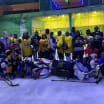Mike Richter, the former New York Rangers goalie, summed up why the hockey community is working to combat climate change: free ice.
"The ponds froze in [Philadelphia] when I was a little kid and it was free ice, you don't have to pay anything, you just go out and play," said Richter, who helped the Rangers win the Stanley Cup in 1994. "Hockey gets to be a game where you have to purchase artificial ice. ... I'm in Connecticut, it's almost $500 an hour. When you think about it, if you get it free outside, that's how Guy Lafleur, that's how the roots of our game started."
Richter was among a panel of current and former NHL players who recently discussed the connection between hockey and the environment during a White House Environmental Roundtable with Environmental Protection Agency Administrator Michael S. Regan.
Boston Bruins center Patrice Bergeron and San Jose Sharks defenseman Mario Ferraro joined Richter in the roundtable that was moderated by Andrew Ference, the NHL's Director of Social Impact, Growth & Fan Development.
Regan said the session was timely, with wildfires in the Western United States, floods in the country's midsection and hurricanes on the East Coast providing the latest evidence of the Earth's changing climate.
"The urgency to act is unmistakable," he said. "So people are seeing and feeling the need to redouble our efforts and move urgently on climate change."
The Biden administration hopes to make inroads by moving to phase down the use of hydrofluorocarbons -- or HFCs -- which are used in air conditioning and as refrigerants that produce greenhouse gas emissions; by developing a proposal to reduce methane pollution and by setting a goal to push sales of electric vehicles to 50 percent of new car purchases by 2030.
Regan said Washington's biggest impact on the environment could come from bipartisan infrastructure legislation that recently passed in the U.S. Senate and would spend billions to remove and replace contaminated lead pipes from water systems.
"It's crazy to think that there are six to 10 million people who are drinking water out of lead pipes," Bergeron said. "I'll be completely transparent, this is something that I didn't know a lot about, environmental justice. In fact, I have a lot to learn about the environment in general and I want to be part of that solution, me and my family."
NHL teams and their venues are doing their part for the planet. The League's 32 teams have taken environmental consciousness beyond improving recycling efforts and installing energy-saving LED lights as symbols of their commitment to improve the environment.
The NHL received the 2015 Green Power Leadership Award from the EPA in 2015 for its overall strategy and impact on the green power market.
Multipurpose sports and entertainment venues like the Seattle Kraken's Climate Pledge Arena and the New York Islanders' new UBS Arena were designed and built with environmental impact in mind.
Several NHL teams have replaced fossil fuel-powered ice resurfacing machine at their arenas and practice facilities with electric powered ones.
Solar panels and electric car charging stations can be seen at arenas and practice sites from the Philadelphia Flyers Skate Zone in Voorhees, New Jersey, to the Anaheim Ducks' Great Park Ice & FivePoint Arena in Irvine, California.
Teams like the Ducks and Kraken are using recycled rainwater to help resurface or lay down ice.
Even the jerseys worn by NHL players this season will be green; manufactured by adidas, they will be made from recycled plastic materials, Ference said.
"It's very cool to be involved in that and know that the sport that I play, that I love, that I do every day … takes part in sustaining the environment," Ferraro said. "Hockey is about leadership, it's about teamwork, and that's what this is about, too."

















